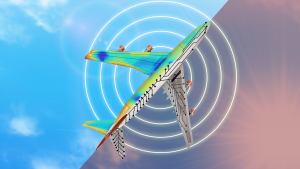Reliable operation to specification of communications systems, navigation equipment and RADAR detection systems is critically important for safe operation of aircraft. The cost of physical testing, and particularly of in-flight testing, of communications systems is very high. Reducing this to a minimum by using simulation for virtual prototyping is crucial in order to meet stringent budgetary and time-to-market requirements. Learn more at our dedicated Aircraft Communication and Detection System Performance page.
The aviation industry is already booming, and it is poised to become even bigger in coming years, with commercial aircraft production projected to increase by 50 percent in the next two decades. Not only are aircraft and aircraft systems becoming more numerous, but they are becoming more complex, which presents new challenges to the aerospace workforce. As the technology gets more complicated, an increasing variety of technical skills are required for employees to be able to work in the ever-changing aerospace industry.
Therefore, the technology needs to be as accessible as possible. An example of a rapidly advancing area of aerospace is aircraft communication and detection system performance, which involves antenna design and operation. A solid simulation program can improve the ability of engineers to design and validate antenna systems even as they become more complicated and face stricter standards and regulations.

SIMULIA’s simulation technology allows engineers to virtually validate antenna concepts and determine how the antenna will perform when installed on the aircraft. It also enables them to address growing problems such as interference from multiple co-existing radio systems. These issues can be solved at a very early stage in the design process, reducing overall device design time and leading to better performance.
Access more relevant Aerospace and Defense content, here.
These simulation solutions allow engineers to work together and share knowledge and information in an easy and streamlined way, through a digitally connected collaborative platform. Engineers from varying disciplines working on systems engineering can synchronize antenna, electronics and mechanical CAD data to provide digital continuity from requirements to architecture to components design. A model-based rather than file-based approach allows them to share a common design, quickly make changes to the product, improve engineering efficiency, and transfer knowledge of the design process and requirements.
Antenna prototyping tools and multiple solver technologies allow engineers to quickly select a first antenna candidate and the most efficient simulation approach for a particular application. Virtual testing enables early validation of the digital design model, decreasing integration and test time and improving product performance.
Reduction of time to market and more effective communication and collaboration are only a couple of benefits of SIMULIA’s solution. Automated meshing of complex geometry allows for a rapid simulation turnaround time, and simulation-ready antenna concepts can be generated in minutes and integrated easily into the complete design. Overall product quality is improved, and development time and cost of physical testing are improved.
Numerous components must work together to make an aircraft function optimally. Through effective simulation, product performance and passenger satisfaction are improved, and 100 percent compliance with required certification and safety standards can be ensured.
